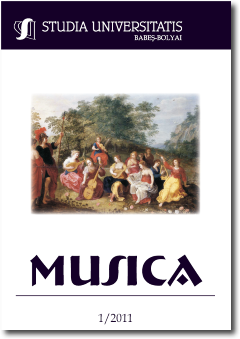MOZART’S MINUET
Keywords:
minuet, Menuetto, Mozart, opera, chamber musicAbstract
Wolfgang Amadeus Mozart (1756-1791) composed his first minuet to his parents on 16 December 1761, before he was 5 years old. Following the historical evolution of the chamber genre, we notice the interest of the composers in adopting the minuet within the cycle and adapting it to a certain period or style. The minuet was probably the first dance included in the Italian symphonies in the beginning of the 18th century. Domenico Scarlatti for example, ends his opera overtures with a movement called „Tempo di menuetto” (in Narciso) using the binary form made up of two eight measure periods. In Mozart’s work, the minuet can be found in the symphonic genre, in concerts, in opera and in the chamber music. The number of minuets in Mozart’s symphonic works is remarkable: almost thirty of his symphonies have a minuet in the third part. Mozart will dedicate the Simfonie Menuett K.409 in C major to this dance (1782). Regarding the affectus of Mozart’s minuet, we ascertain the following: the minuet appears as an independent piece or as part of a cycle. The aspects of the tempo are implied tempo, Tempo di Menuetto, Moderato, Allegretto or Allegro. Indications referring to character appear: Menuetto-galante, Menuetto Maestoso On conclusion, the initial simplicity of the phrase and harmony allowed a series of innovations required by the aesthetics of the Rococo: harmonic and tonal contrasts, the infiltration of new ternary styles and the counterpoint writing.
References
***, Dicţionar de termeni muzicali (Dictionary of Musical Terms), The Scientific and Encyclopedic Publishing House, Bucharest, 1984.
***, New Grove Dictionary of Music and Musicians, vol. XVI, edited by Stanley Sadie, Macmillan Publishers, London, 1992.
Angi, Ştefan, Prelegeri de estetică muzicală (Lectures of Musical Aesthetics), vol. II, tom 1, the Publishing House of the University in Oradea, 2004.
Berger, Wilhelm Georg, Estetica sonatei clasice (The Aesthetics of the Classical Sonata), the Musical Publishing House, Bucharest, 1981.
Brockhaus - Riemann, Zenei Lexikon (Musical Encyclopaedia), Editio Musica, Budapest, 1984, vol II.
Cojocaru, Dora, W.A. Mozart - “Cvartetele haydniene” (The Quartets for Haydn), the Musical Publishing House, 2000.
Eliade, Mircea, Eseuri. Mitul eternei reintoarceri. Mituri, vise and mistere (Essays. The Myth of the Eternal Return. Myths, Dreams and Mysteries), the Scientific Publishing House, Bucharest, 1991.
Glock, William, The comment on the CD Mozart, Klaviersonaten, EMI Records Ltd., 1991.
Pándi, Marianne, Hangversenykalauz (Concert Guide) vol. III Kamaraművek (Chamber Music). Zeneműkiadó, Budapest, 1975.
Szabolcsi, Bence, Musica Mundana. Relations of Rhythm, Melody, Emotions and Forms in the Music of the World, Editio Musica, Budapest, Hungaroton, 1976.
Timaru, Valentin, Analiza muzicală intre conştiinţa de gen and conştiinţa de formă (Musical Analysis between the Conscience of Genre and the Conscience of Form), the Publishing House of the University in Oradea, 2003.
Vályi, Rózsi, A táncművészet története (The History of the Art of Dance), Zeneműkiadó, Budapest, 1969.
Varga, Ovidiu, Wolfgang Amadeus Mozart, the Musical Publishing House, Bucharest, 1988
Vianu, Tudor, Problemele metaforei (Problems of the Metaphor), in: Opere (The Works), vol. IV, Minerva Publishing House, Bucharest, 1975.
Downloads
Published
How to Cite
Issue
Section
License
Copyright (c) 2011 Studia Universitatis Babeș-Bolyai Musica

This work is licensed under a Creative Commons Attribution-NonCommercial-NoDerivatives 4.0 International License.



